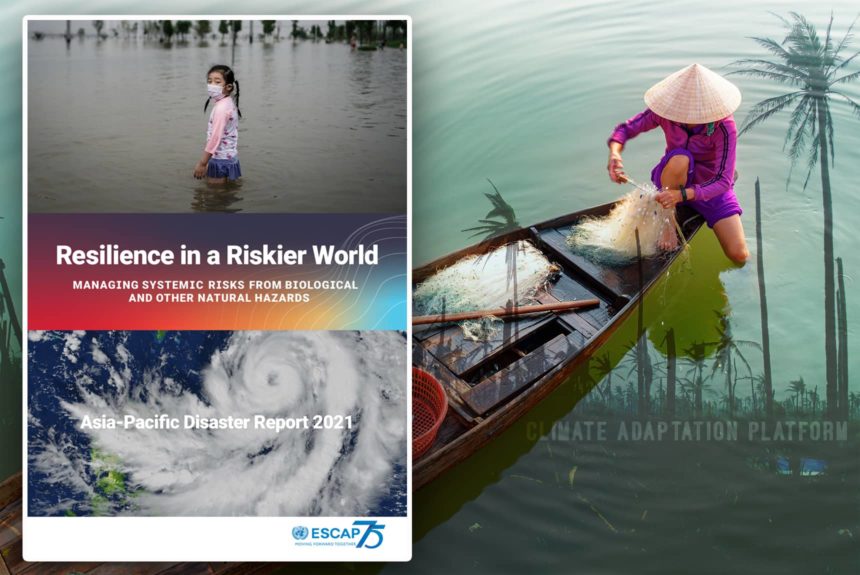Improvements in disaster management and preparedness in the Asia-Pacific have significantly reduced fatalities and losses from natural and man-made disasters over the last two decades.
However, the onset of the COVID-19 pandemic and the ongoing climate crisis have been a game-changer, escalating the impacts of natural disasters and exposing vulnerabilities in the region. Most countries in Asia and the Pacific struggle to cope with multiple and overlapping problems.
“The Asia-Pacific Disaster Report 2021 addresses the complexity of these converging and cascading risks by analysing hazards (natural and biological) simultaneously, presenting the impacts of cascading risks on populations and infrastructure under current, moderate and worst-case climate change scenarios. It focuses on five risk hotspots of particular concern.”
For the first time, the report combined data on multiple hazards – biological, natural, and climate change- to–to identify hotspots, regions where people are simultaneously exposed to numerous risks. And these identified hotspots in the report are as follows:
- East and North-East Asia, where heatwaves and related biological hazards are increasing along with the existing riskscape of earthquakes and tropical cyclones
- North and Central Asia, where high per capita rates of COVID-19 are being superimposed on new areas of drought and biological hazards due to climate change.
- South and South-West Asia, as well as South—East Asia, are among the global epicentres of COVID-19. The pandemic is being superimposed on floods, droughts, and cyclones, which are being exacerbated by climate change, leading to systemic failures. The multiple hazards threaten to reverse the gains in poverty reduction and the achievement of the Sustainable Development Goals.
- Pacific small island developing States — where emerging high rates of COVID-19 are being superimposed on cyclones and multiple other hazards exacerbated by climate change, leading to an emerging and complex riskscape not seen before.
Disasters are not only a threat to human lives but also to livelihoods. Climate change will exacerbate these impacts, making them more severe and costly.
The report estimates that the annual losses from natural and biological hazards across Asia and the Pacific amount to around $780 billion. However, these yearly losses could rise to $1.3 trillion, equivalent to 4.2% of GDP, in a worst-case climate change scenario.
Armida Salsiah Alisjahbana, the UN Under-Secretary-General and Executive Secretary of the United Nations Economic and Social Commission for Asian and the Pacific (UNESCAP), writes that:
“Rather than regarding the human and economic costs as inevitable, countries would do far better to ensure that their populations and their infrastructure were more resilient. This would involve strengthening infrastructures such as bridges and roads, as well as schools and other buildings that provide shelter and support at times of crisis.”
She also notes that governments should invest in more robust health infrastructure. Although these investments or costs of adaptation to natural and biological hazards will require significant resources amounting to S270 billion, this would only represent one-fifth of the yearly losses, equivalent to 0.85% of the Asia-Pacific’s GDP.
Funding for climate adaptation can come from expected fiscal revenues or innovative new resources, such as climate-resilient bonds, debt-for-resilience swaps, and debt relief initiatives.
Alisjahbana writes further about the report, “COVID-19 has demonstrated yet again how all disaster risks interconnect – how a public health crisis can rapidly trigger an economic disaster and societal upheaval. This is what is meant by ‘systemic risk,’ and this is the kind of risk that policymakers now need to address if they are to protect their poorest people.” She said further:
“This does not simply mean responding rapidly with relief packages but anticipating emergencies and creating robust systems of social protection that will make vulnerable communities safer and more resilient.”
“Fortunately, as the report illustrates, new technology, often exploiting the ubiquity of mobile phones, is presenting more opportunities to connect people and communities with financial and other forms of support.”
“To better identify, understand and interrupt the transmission mechanisms of COVID-19, countries have turned to frontier technologies such as artificial intelligence and the manipulation of big data. They have also used advanced modelling techniques for early detection, rapid diagnosis and containment.”
The 100+ page report contains four chapters.
Chapter 1 – The Shifting Contours of the Asia-Pacific Disaster Riskscape discusses how risks in the region are changing and expanding, compounded by the pandemic and climate change.
Chapter 2 – Managing Disasters during a Global Pandemic discusses the challenges faced by the Asia-Pacific region in controlling the pandemic while coping with and addressing natural disasters. The pandemic has exacerbated the impacts of floods, droughts, cyclones, and locust swarms, making an effective response even more challenging.
Chapter 3 – Hotspots of exposure to cascading risks, identifies regions in Asia and Pacific that are contending with the simultaneous effects of the slow onset of climate change and disasters, in addition to the pandemic and extreme events and its impact on the economy, infrastructure, economy, health, and livelihoods.
Chapter 4 – The scaled-up contours of a regional resilience response. The global experience of the pandemic served as a wake-up call and a stark reminder that humanity will always be vulnerable to natural forces. This chapter gives out recommendations, in the form of ‘four national priority action areas’, on how the region can respond to the simultaneous threats it faces. It also highlights the importance of regional and subregional coordination and action.
Read the entire report by clicking on the link below:
Sources:
Resilience in a Riskier World. Managing Systemic Risks From Biological and Other Natural Hazards. (2021). The Economic and Social Commission for Asia and the Pacific. Retrieved from https://www.unescap.org/sites/default/d8files/knowledge-products/Asia-Pacific%20Disaster%20Report%202021_full%20version_0.pdf
Alisjahbana, A. (2021 August 26). Resilience in a riskier world. Asia and The Pacific Policy Society. Retrieved from https://www.policyforum.net/resilience-in-a-riskier-world/



Leave a Reply